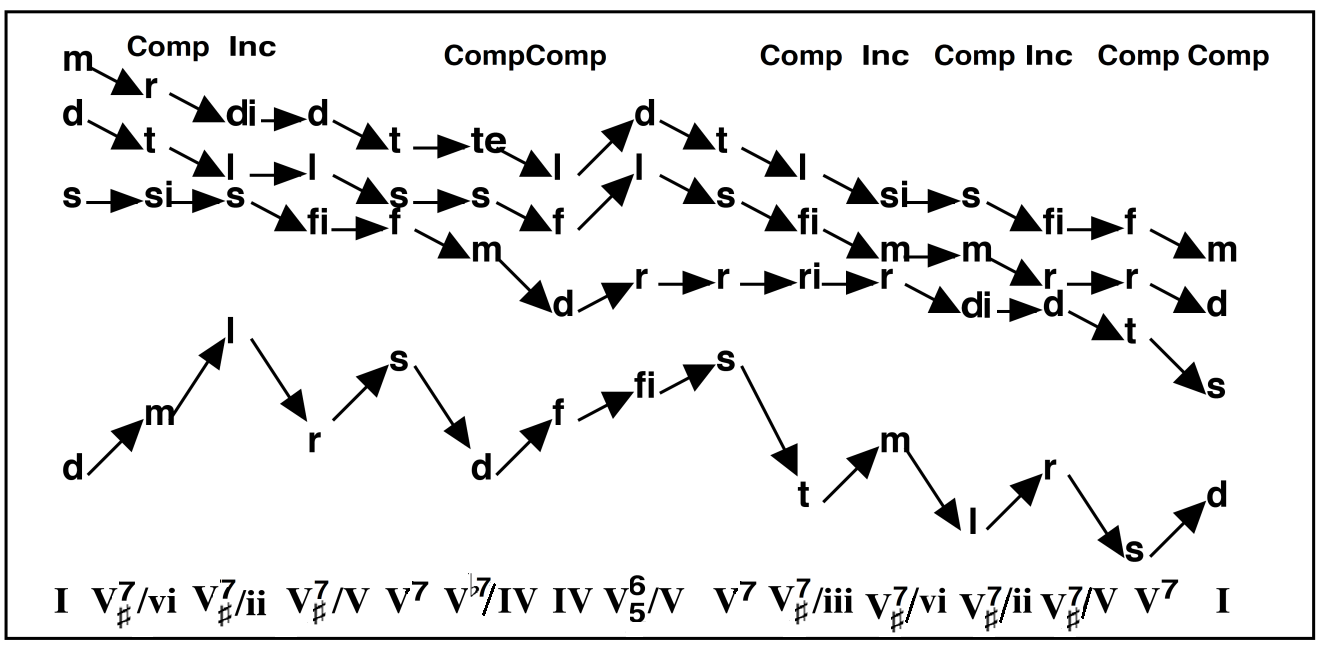22 Chromatic Sequences
chromatic sequences based on the circle of fifths
When the imperfect circle of fifths (see the chapter on Diatonic Sequences) is adjusted to falling perfect 5ths (fa – ti becomes fa – te), every chord becomes the dominant of the next, resulting in the perfect circle of fifths.
-
The imperfect circle of fifths
-
The circle of perfect fifths avoids the A4/d5 between fa and ti
- In the complete circle of perfect fifths, every chord is the dominant of the next chord. Note that in the literature, sequences typically only employ several of these links.
a. Triad to 7th chromatic sequence
Note that the 3rd of the first chord becomes the 7 th of the next chord (3-7, 7-3).
b. Triads with passing 7ths
c. Variant of 7th to 7th using inversions
2 to ![]() with passing 7ths on every chord
with passing 7ths on every chord
d. Combination of possible secondary dominant sevenths
Each secondary dominant seventh chord resolves to the next secondary dominant seventh chord a perfect fifth below. Observe the alternating chain of complete to incomplete dominant seventh chords.

Note that the secondary dominant sequential pattern ends with the IV chord, as the V7 of viio is not available.
e. Chromatic sequences in minor
Chromatic sequences are most commonly used in major keys. In minor, the use of the Neapolitan chord (see Chapter 25) creates the circle of perfect fifths up to the cadence.
f. Descending chromatic sequence using secondary diminished seventh chords
In this variant, a secondary diminished seventh chord resolves to a root position diatonic triad.
f. Parallel diminished seventh chords
In this highly chromatic variant, a root position diminished seventh chord on G![]() descends to a second inversion diminished seventh chord on C
descends to a second inversion diminished seventh chord on C![]() . That progression is then sequenced down a major 2nd.
. That progression is then sequenced down a major 2nd.
The progression can be analyzed as a secondary dominant circle of perfect fifths progression (viio7/Am – viio![]() /Dm | viio7/Gm – viio
/Dm | viio7/Gm – viio![]() /C | viio7/F ), though it sounds like parallel diminished seventh chords.
/C | viio7/F ), though it sounds like parallel diminished seventh chords.
chromatic sequences ascending by step
A falling 3rd root pair that ascends by a step (#1) can be converted into a chromatic sequence of secondary dominants (#2).
a. Ascending chromatic sequence using secondary dominants
In this version, the bass descends by a 3rd. The second chord then becomes the dominant of the next chord.
b. Ascending chromatic sequence using secondary dominant seventh chords
c. Ascending chromatic sequence using secondary diminished seventh chords
The Chromatic Sequence as a Modulating Device
The chromatic sequence is used to modulate to closely related and distant keys. Begin with an ascending or descending secondary dominant chromatic sequence, cut off the progression after two or three repetitions, and conclude with a cadence in the new key.
A. Descending sequences leading to a new key
Using the imperfect circle of fifths (descending secondary dominant seventh chord) sequence:
Using the perfect circle of fifths (descending secondary dominant) sequence:
In this example, the sequence has three pairs (F to E![]() to D
to D![]() ) and that the E-flat major triad in measure 2 (D
) and that the E-flat major triad in measure 2 (D![]() : V/V) moves to the new key.
: V/V) moves to the new key.
Using secondary diminished seventh chords:
B. Ascending sequences leading to a new key
This ascending secondary dominant sequence has three pairs: F to G to A.
With inversions:
Practice 1
For each of the examples above:
- Transpose into several other keys
- Play at the keyboard
Practice 2